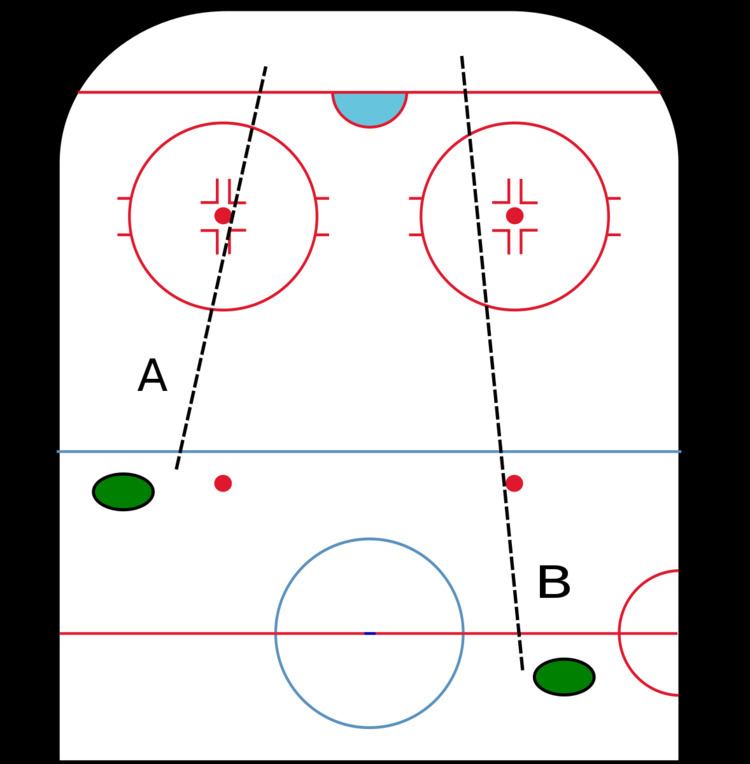 | ||
Icing is an infraction in the sport of ice hockey. It occurs when a player shoots the puck across both the centre red line and the opposing team's goal line, and the puck remains untouched. However, it is not icing if the puck is shot from behind the halfway line into the goal, or when the shot must be played by the opposing team's goaltender to keep it out of the net. In the former case with a shot puck crossing the goal line completely, the goal is counted.
Contents
A major exception is when a team is shorthanded. A team trying to kill a penalty may legally "ice the puck". A team on a power play, however, must still follow the icing rules.
When icing occurs, a linesman stops play. Play is resumed with a faceoff in the defending zone of the team that committed the infraction.
Variations
There are three variations of icing: no-touch or automatic icing, touch icing, and hybrid icing.
In touch icing, a player on the opposing team other than the goaltender must touch the puck to cause the stoppage of play. If the puck is first touched by the goaltender or a player on the team that iced the puck, icing is waved off (cancelled) and play continues. The icing rule can lead to high-speed races for the puck. While an icing call is pending, the linesman raises an arm to indicate that a potential icing call may be made. If the icing is waved off, the official lowers his arm and gives the washout signal (extending both arms sideways from the body at shoulder height, similar to the "safe" sign in baseball but typically delivered from a less-crouched or fully upright position).
Most amateur leagues worldwide use no-touch or automatic icing, where play is stopped for icing immediately once the puck crosses the goal line.
International IIHF rules, the National Hockey League, American Hockey League, NCAA college hockey, European professional leagues, and several minor North American leagues (ECHL, Central Hockey League and SPHL) use hybrid icing. Play is stopped immediately if the player on the opposing team reaches the faceoff dot first, instead of skating all the way across the goal line to touch the puck. This type of icing is intended to reduce the number of collisions along the boards during touch icing, but still allowing the team that iced the puck to get to it first to wave off the icing. In instances where the puck is shot around the end boards, travels down the ice and comes out the other end, the linesman has to determine who would have touched the puck first. If it's the defending player, he calls an automatic icing but if it's the attacking player he lets the play continue. The NHL adopted this variation as its rule beginning with the 2013–14 season, after several decades of using touch icing. The IIHF then adopted it in 2014 after a few decades of using no-touch icing.
Exceptions
Icing is always waved off in the following situations:
History
The icing rule was passed in September 1937 by the National Hockey League (NHL). It was done to eliminate a common delaying tactic used by teams to protect a winning margin. A November 18, 1931, game is cited as one extreme example that led to the ban on the practice. The New York Americans, protecting a 3–2 lead over the Boston Bruins at Boston Garden, iced the puck over 50 times. The crowd became incensed and threw debris onto the ice, causing a delay while the teams were sent to their dressing rooms. When the teams met again that December 3 in New York, the Bruins iced the puck 87 times in a scoreless draw.
The rule was amended in June 1951, whereby if the goaltender touched the puck, the infraction was nullified. For the 1990–91 season, the league amended it to nullify the infraction if the puck passed through or touched the goal crease when the goaltender had been removed for an extra attacker. The rule was later amended by the NHL to nullify icing if the goaltender moved towards the puck as it approached the red line.
The 1970s-era World Hockey Association never adopted the NHL rule of allowing shorthanded teams to ice the puck. In 2009, USA Hockey considered eliminating the shorthanded icing rule, having tested its elimination in Massachusetts and Alaska in the 2007-2009 seasons.
The IIHF adopted the no-touch icing rule after an incident in the Czechoslovak First Ice Hockey League in 1990, when Luděk Čajka, rushing to get to the puck in an icing situation, crashed into the boards, suffered severe spinal injuries, and died a few weeks later.
After some teams in need of a line change (player substitution) began deliberately icing the puck to stop play, and as part of a group of important rules changes following the 2004–05 NHL lockout, the NHL supplemented the icing rule prior to the 2005–06 season by not allowing the offending team to substitute players before the next faceoff, except to replace an injured player or when the goaltender must return to the net following an icing call. This change was made in an effort to speed up game play by reducing icing infractions, as well as to encourage teams to work the puck up the ice rather than taking the opportunity to rest their players. In some Junior leagues (such as the WHL), the offending team is permitted to substitute players after an icing only if the puck was shot from the neutral zone (between the defensive blue line and the red line). If the violation occurs in the defensive zone, substitution is prohibited.
The NHL began using hybrid-icing rules in the 2013–14 season, after several decades of using touch icing. The IIHF also switched to hybrid after the conclusion of the 2014 World Championship.
